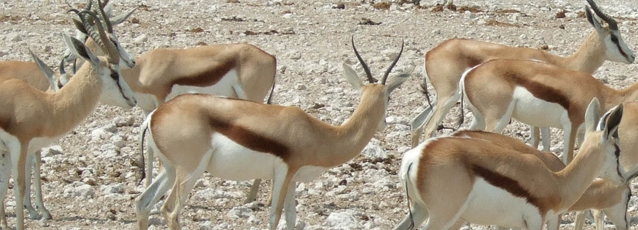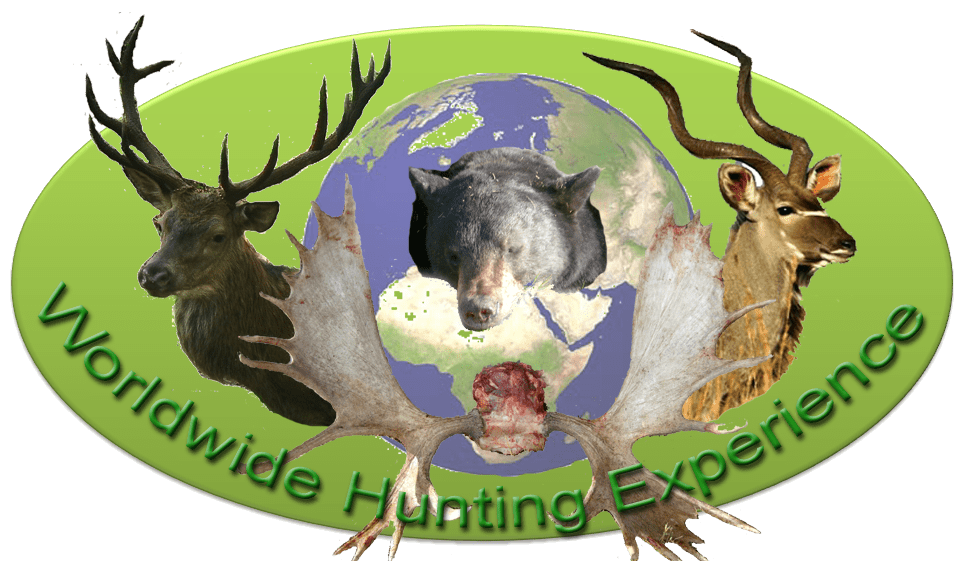SPRINGBUCK
Physical characteristics and distribution
Body length: females: 120 – 145 cm, males: 125 – 150 cm
Weight: females: 20 – 30 kg, males: 25 – 35 kg
Life expectancy: 9 – 12 years
Distribution: southern Africa
Habitat: savannah, semi-deserts
Species: several 100,000, not endangered
Weight: females: 20 – 30 kg, males: 25 – 35 kg
Life expectancy: 9 – 12 years
Distribution: southern Africa
Habitat: savannah, semi-deserts
Species: several 100,000, not endangered

Appearance
Like the gazelle, the springbok has a light, slender body. He stands on long, thin legs, the head is small and narrow. The springbok has long ears that are slightly rounded. The eyes are big and dark, the snout is narrow. His coat is light brown at the back and white at the belly. Between the top and bottom there is a dark brown stripe. The head is white. From the eyes to the corners of the mouth, however, there is a dark line in each case. On the back of the springbok has extended hair, but only visible in a characteristic jump. Both sexes carry ringed horns, which can be up to 36 inches long. The horns of the females are thinner than those of the males. From the middle of the back to the root of the tail there is a skin fold on both sides of the body which can be folded down.
Reproduction and development
Rarely, twin births are possible. Springboks are nest-breeders. They are already born fully developed and can follow their mother after only a few hours. The father is not involved in the rearing. The boys are suckled by their mother for about a year. Then they become sexually mature and weaned. In May, the mating season begins for springboks. At this time, a male gathers a whole flock of females around him. A buck can carry a herd of up to 30 females. When all females are in their territory, the buck marks the area and chases away potential rivals. After a gestation period of almost six months, every female gives birth to a baby.
Lifestyle and behavior
Lifestyle and behavior
Springbok are very sociable. They form mixed herds and bachelor groups. In the rainy season, a herd can consist of several thousand animals. This herd then often mixes with packs of other gazelles, zebras and ostriches. Only at mating season, these herds dissolve, and a buck flocks several females around. Springboks are active both during the day and at night. Only in the hot midday hours do they retreat to the shadows and rest. Springboks usually move quite slowly. On the run, however, they leap forward quickly. They jump with all four legs at the same time in the air and let hang head and legs. When jumping, the skin fold on the back opens, and the white fur underneath becomes visible. This characteristic locomotion has given them their name; she is called Prunken.
Springbok are very sociable. They form mixed herds and bachelor groups. In the rainy season, a herd can consist of several thousand animals. This herd then often mixes with packs of other gazelles, zebras and ostriches. Only at mating season, these herds dissolve, and a buck flocks several females around. Springboks are active both during the day and at night. Only in the hot midday hours do they retreat to the shadows and rest. Springboks usually move quite slowly. On the run, however, they leap forward quickly. They jump with all four legs at the same time in the air and let hang head and legs. When jumping, the skin fold on the back opens, and the white fur underneath becomes visible. This characteristic locomotion has given them their name; she is called Prunken.
Feeding
The springbok feeds mainly on different grasses and herbs. He also loves to eat the foliage of acacia bushes. To reach high branches, the springbok stands on its hind legs. If a few grasses are found, it also eats tubers and onions, which it plows out of the ground. The springbok drinks a lot of water every day, but can also get along without a drink for a while.
Hunting style, equipment and countries
Springboks are found in southern Africa, especially in the open steppe regions such as Namibia and South Africa. There are different natural color spectra with white, black, copper and normal colored springboks. The hunt takes place mostly on the stalk but can also be combined with Ansitz at waterholes.
Hunting trip Countries
IF YOU HAVE ANY QUESTIONS OR ARE INTERESTED IN A MEDIATION OFFER FOR HUNTING TRIPS AND HUNTING FOR SPRINGBUCK, PLEASE CONTACT US VIA EMAIL OR CONTACT FORM.
All offered trips are arranged by us and carried out by our partners as organizers.
